ICU谵妄和ABCDE集束化预防方案
ICU后综合征在镇痛镇静谵妄指南、镇痛镇静集束化措施及eCASH中的干预建议(最全版)
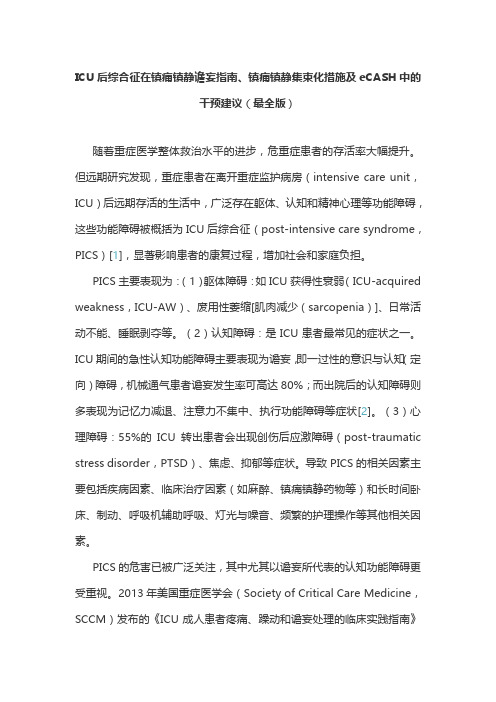
ICU后综合征在镇痛镇静谵妄指南、镇痛镇静集束化措施及eCASH中的干预建议(最全版)随着重症医学整体救治水平的进步,危重症患者的存活率大幅提升。
但远期研究发现,重症患者在离开重症监护病房(intensive care unit,ICU)后远期存活的生活中,广泛存在躯体、认知和精神心理等功能障碍,这些功能障碍被概括为ICU后综合征(post-intensive care syndrome,PICS)[1],显著影响患者的康复过程,增加社会和家庭负担。
PICS主要表现为:(1)躯体障碍:如ICU获得性衰弱(ICU-acquired weakness,ICU-AW)、废用性萎缩[肌肉减少(sarcopenia)]、日常活动不能、睡眠剥夺等。
(2)认知障碍:是ICU患者最常见的症状之一。
ICU期间的急性认知功能障碍主要表现为谵妄,即一过性的意识与认知(定向)障碍,机械通气患者谵妄发生率可高达80%;而出院后的认知障碍则多表现为记忆力减退、注意力不集中、执行功能障碍等症状[2]。
(3)心理障碍:55%的ICU转出患者会出现创伤后应激障碍(post-traumatic stress disorder,PTSD)、焦虑、抑郁等症状。
导致PICS的相关因素主要包括疾病因素、临床治疗因素(如麻醉、镇痛镇静药物等)和长时间卧床、制动、呼吸机辅助呼吸、灯光与噪音、频繁的护理操作等其他相关因素。
PICS的危害已被广泛关注,其中尤其以谵妄所代表的认知功能障碍更受重视。
2013年美国重症医学会(Society of Critical Care Medicine,SCCM)发布的《ICU成人患者疼痛、躁动和谵妄处理的临床实践指南》(简称PAD指南)[3]指出,谵妄会增加ICU成人患者的病死率、延长ICU 住院日和总住院时间;ICU期间发生谵妄与ICU转出后发生的认知障碍相关。
研究表明,早期活动、合理的镇静和早期心理支持对预防PICS有较好效果[4]。
ICU病人谵妄躁动的处理
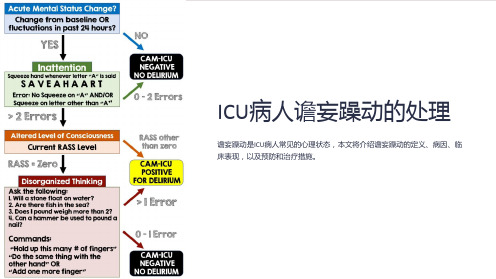
药物治疗的原则与方法
药物治疗原则 药物给药方式
灵活应用药物,并根据病情调整剂量和给药方式。
静脉给药、雾化吸入给药和口服给药等方式可根 据病人情况选择。
谵妄躁动的预后及后续照顾
1 预后
谵妄躁动通常在积极治疗后能够得到改善,并不会对病人的长期健康产生明显影响。
2 后续照顾
病人出院后,家属和医护人员需要给予持续的心理支持,以帮助病人恢复身心健康。
预防
通过减少诱发因素、提供舒适的环境、限制物理约 束等手段可以有效预防谵妄躁动的发生。
专业护理干预
1
环境控制
调整光线、降低噪音等措施,创造舒适的ICU环境。
2
情绪支持
护理人员的情绪支持和安慰能减少病人的焦虑和恐惧。
3
镇痛治疗
科学合理地给予镇痛治疗,缓解疼痛带来的焦虑和不适。
中药干预
中药治疗
选用适当的中药来改善病人的心理状态,并降低谵妄躁动的发生。
ICU病人谵妄躁动的处理
谵妄躁动是ICU病人常见的心理状态,本文将介绍谵妄躁动的定义、病因、临 床表现,以及预防和治疗措施。
定义
1 什么是谵妄躁动?
谵妄躁动是指在ICU环境中,病人出现思维混乱、认知障碍以及情绪异常的症状。
病因及流行病学
1 病因复杂多样
谵妄躁动可能由多种因素引起,包括药物副 作用、疼痛、感染、睡眠障碍等。
结语
谵妄躁动是ICU病人常见问题,但通过合理的预防和专业护理干预,我们可以最大程度地减少其发生,提高病 人的康复率。
2 高发人群
特定群体如老年病人、重症监护病人以及有 心理疾病史的患者更容易出现谵妄躁动。
临床表现
1 认知功能障碍
病人可能出现注意力不集中、错觉、幻觉以及记忆困难等认知障碍症状。
对ICU谵妄患者采用集束化护理的预防效果分析

对ICU谵妄患者采用集束化护理的预防效果分析发表时间:2016-05-12T16:12:58.150Z 来源:《系统医学》2016年第4期作者:刘艳李慧[导读] 观察组ICU谵妄患者护理后的ICU住院时间和谵妄持续时间明显优于对照组ICU谵妄患者,观察组ICU谵妄患者护理后的谵妄发生率明显低于对照组ICU谵妄患者(P<0.05)。
结论:给予ICU谵妄患者采用集束化护理,不仅能够有效降低谵妄发生率,还能减少ICU住院时间和谵妄持续时间。
刘艳【1】李慧【2】新津县人民医院 ICU 四川成都 611430【摘要】目的:分析对ICU谵妄患者采用集束化护理的预防效果。
方法:选取我院ICU谵妄患者50例,接受治疗的时间为2013年3月至2015年5月期间,随机分为两组(观察组和对照组),每组各有25例患者,对照组采用常规护理,观察组采用集束化护理,比较两组患者护理后的ICU住院时间、谵妄持续时间和谵妄发生率。
结果:观察组ICU谵妄患者护理后的ICU住院时间和谵妄持续时间明显优于对照组ICU谵妄患者,观察组ICU谵妄患者护理后的谵妄发生率明显低于对照组ICU谵妄患者(P<0.05)。
结论:给予ICU谵妄患者采用集束化护理,不仅能够有效降低谵妄发生率,还能减少ICU住院时间和谵妄持续时间。
【关键词】集束化护理;ICU谵妄患者;常规护理【中图分类号】R47【文献标识码】A【文章编号】2096-0867(2016)-04-313-01谵妄是临床上较为严重且多发的疾病[1],为此,我院选取了50例ICU谵妄患者实施不同的护理,以此观察ICU谵妄患者护理后的效果,以供临床参考,具体内容见下文。
1资料和方法1.1基线资料选取我院ICU谵妄患者50例,接受治疗的时间为2013年3月至2015年5月期间,随机分为观察组和对照组,观察组患者25例,对照组患者25例。
观察组ICU谵妄患者,男女比例为10:15,年龄30~60岁之间,平均年龄为(40.35±2.45)岁。
集束化护理在预防ICU谵妄中的应用效果分析

集束化护理在预防 ICU谵妄中的应用效果分析摘要:目的:探究在预防ICU谵妄中应用集束化护理的临床效果。
方法:2020年3月至2020年12月,从我院选取100例重症监护室(ICU)患者作为研究对象,采用随机数字表法将所选研究对象分为对照组和观察组,各组均为50例患者,对照组行常规护理干预,观察组以常规护理干预为基础行集束化护理,比较两组患者谵妄发生率、住院时间以及护理满意度。
结果:对照组行常规护理,观察组行集束化护理后,对照组谵妄发生率为30.00%,观察组谵妄发生率为12.00%,观察组低于对照组,差异显著有统计学意义(P<0.05)。
与对照组护理满意度(84.00%)比较,观察组护理满意度为96.00%,观察组显著高于对照组,差异显著有统计学意义(P<0.05)。
结论:ICU患者应用集束化护理的临床效果显著,降低了谵妄发生率,缩短了患者的住院时间,提升了患者的护理满意度,建议临床推广与应用。
关键词:集束化护理;ICU;谵妄;满意度医院中,ICU属于一个重要科室,该科室中患者普遍存在病情重、发展快等特点,需积极结合患者实际情况拟定不同监护方案。
谵妄属于一种在ICU中较为常见的并发症,以患者认知功能障碍、意识模糊错乱为主要临床症状。
当ICU患者出现谵妄时,会对患者的身心健康产生严重影响,不仅导致患者ICU住院时间被延长,而且会对患者的认知功能产生严重影响,加大了患者的死亡率[1]。
因此,积极采取有效的护理措施以预防发生谵妄对于ICU患者具有十分重要的意义。
本研究于2020年3月至2020年12月期间从我院选取100例重症监护室(ICU)患者作为研究对象,则对集束化护理的临床效果予以探究分析。
1资料与方法1.1一般资料2020年3月至2020年12月,从我院选取100例重症监护室(ICU)患者作为研究对象,通过运用随机数表法将其分为对照组(n=50)和观察组(n=50)。
对照组男性、女性患者分别有28/22例,年龄介于46~71岁之间、平均年龄为(56.62±5.41)岁;观察组男性、女性患者分别有27/23例,年龄介于45~70岁之间、平均年龄为(55.61±5.42)岁。
ABCDEF集束化策略在ICU谵妄患者中的应用
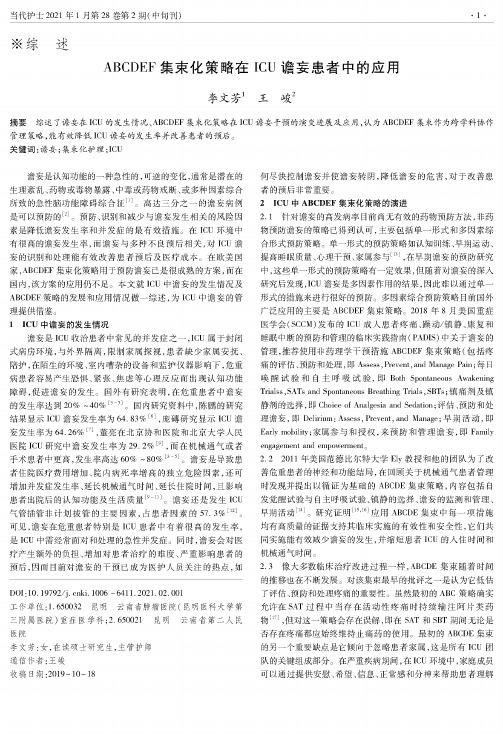
当代护士2021年1月第28卷第2期(中旬刊)-1-※综述ABCDEF集束化策略在ICUB妄患者中的应用李文芳1王峻2摘要综述了谵妄在ICU的发生情况,ABCDEF集束化策略在ICU谵妄干预的演变进展及应用,认为ABCDEF集束作为跨学科协作管理策略,能有效降低ICU谵妄的发生率并改善患者的预后。
关键词:谵妄;集束化护理;ICU谵妄是认知功能的一种急性的,可逆的变化,通常是潜在的生理紊乱、药物或毒物暴露、中毒或药物戒断、或多种因素综合所致的急性脑功能障碍综合征⑴。
高达三分之一的谵妄病例是可以预防的。
预防、识别和减少与谵妄发生相关的风险因素是降低谵妄发生率和并发症的最有效措施。
在ICU环境中有很高的谵妄发生率,而谵妄与多种不良预后相关,对ICU谵妄的识别和处理能有效改善患者预后及医疗成本。
在欧美国家,ABCDEF集束化策略用于预防谵妄已是很成熟的方案,而在国内,该方案的应用仍不足。
本文就ICU中谵妄的发生情况及ABCDEF策略的发展和应用情况做一综述,为ICU中谵妄的管理提供借鉴。
1ICU中谵妄的发生情况谵妄是ICU收治患者中常见的并发症之一,ICU属于封闭式病房环境,与外界隔离,限制家属探视,患者缺少家属安抚、陪护,在陌生的环境、室内嘈杂的设备和监护仪器影响下,危重病患者容易产生恐惧、紧张、焦虑等心理反应而出现认知功能障碍,促进谵妄的发生。
国外有研究表明,在危重患者中谵妄的发生率达到22%-42%[3-5\国内研究资料中,陈鹏的研究结果显示ICU谵妄发生率为64.83%[6],庞磚研究显示ICU谵妄发生率为44.84%3],董亮在北京协和医院和北京大学人民医院ICU研究中谵妄发生率为22.2%3],而在机械通气或者手术患者中更高,发生率高达64%~82%_5]。
谵妄是导致患者住院医疗费用增加、院内病死率增高的独立危险因素,还可增加并发症发生率、延长机械通气时间、延长住院时间,且影响患者出院后的认知功能及生活质量3宀」。
2022年ICU成人患者谵妄预防及管理(全文)

2022年ICU成人患者澹妄预防及管理(全文)澹妄是高级神经中枢兴奋性增高为主的急性功能失调状态,主要特征为意识障碍和认知功能改变,住院患者澹妄发生率约10%~31%,而ICU患者中澹妄发生率约70%,机械通气患者甚至高达80%o众多证据表明,谣妄将导致ICU患者病死率增加,机械通气时间和住院时间延长,医疗费用增加,严重者可导致长期认知功能障碍,极大影响患者预后。
国外已有较多关于澹妄预防和管理的相关指南,对ICU患者澹妄的风险评估、预防和管理已成为重症医学领域的研究热点。
而国内对澹妄的研究起步较晚,ICU医护人员对澹妄认识度相对较低,对澹妄的评估、预防和管理策略知识缺乏,且ICU患者澹妄管理的临床实施率低,经常被忽视和漏诊,推测可能现有的指南内容繁多,临床护理实践与循证证据之间还存在较大差距有关,因此亟需对适合我国国情、贴合临床实际需求且可行性好的ICU患者谑妄评估、诊断、预防和管理相关证据进行整理、规范和推广。
本研究通过系统检索国内外该领域相关研究,运用循证护理的方法对证据进行评价、综合和总结,形成最佳证据,为规范和推广ICU成人患者请妄预防和管理提供借鉴和参考。
一、澹妄的评估工具和人员要求应使用ICU意识模糊评估量表(CAM—ICU)对重症患者进行澹妄评估(证据等级:1,推荐强度:A)最佳证据2:谣妄的评估应由受过培训并具有诊断澹妄能力的医疗专业人员进行(证据等级:1,推荐强度:A)最佳证据3:应对重症护士及急诊科医生进行澹妄监测相关的培训和教育(证据等级:1,推荐强度:A)二、澹妄监测时机最佳证据4:成人重症患者应使用有效的评估工具进行澹妄常规监测(证据等级:1,推荐强度:A)最佳证据5:每日评估有助于早期发现澹妄(证据等级:5,推荐强度:B)最佳证据6:及时评估患者的意识和行为改变,一旦发现患者出现认知功能、注意力、躯体功能和行为的改变时,应立即进行澹妄评估(证据等级:1,推荐强度:B)最佳证据7:推荐对所有术后患者从术后复苏室即开始监测澹妄,每班评估,直至术后第5天(证据等级:2,推荐强度:B)最佳证据8:所有入院患者存在一种或多种澹妄危险因素时均应使用经过验证的筛查工具进行筛查(证据等级:1,推荐强度:A)最佳证据9:推荐医疗机构应开发和实施每日常规术后澹妄监测的质量改进项目(证据等级:2,推荐强度:B)三、澹妄的高危因素高龄、老年痴呆、昏迷史、合并症(如心脑血管疾病、糖尿病∖入ICU 前的急诊手术或创伤(证据等级:1,推荐强度:A)最佳证据11:疼痛、焦虑、抑郁(证据等级:1,推荐强度:A)最佳证据12:苯二氮卓类药物的使用(证据等级:1,推荐强度:B)最佳证据13:睡眠剥夺(证据等级:1,推荐强度:B)最佳证据14:术中失血、输血、手术部位(腹部、心胸)(证据等级:1,推荐强度:B)疾病严重程度(恶化或有恶化风险的临床症状X证据等级:1,推荐强度:B)四、澹妄的高危诊断最佳证据16:澹妄的诊断应由经过专业训练的医疗专业人员基于DSM或者ICD的诊断标准进行诊断;且有关澹妄的所有诊断应被记录,需要和患者及其照顾者进行讨论(JBI)(证据等级:1,推荐强度:A)最佳证据17:应使用《精神疾病诊断与统计手册》(DSM-V)或ShortCAM明确澹妄诊断,在ICU或术后复苏室则应使用CAM-ICU,且应由经过严格训练具有澹妄诊断能力的医疗专业人员进行诊断评估。
集束化护理预防心外术后患者ICU谵妄的应用与评价
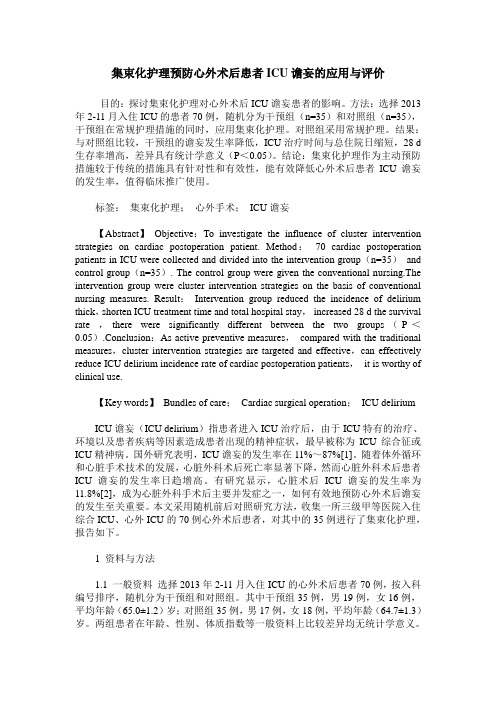
集束化护理预防心外术后患者ICU谵妄的应用与评价目的:探讨集束化护理对心外术后ICU谵妄患者的影响。
方法:选择2013年2-11月入住ICU的患者70例,随机分为干预组(n=35)和对照组(n=35),干预组在常规护理措施的同时,应用集束化护理。
对照组采用常规护理。
结果:与对照组比较,干预组的谵妄发生率降低,ICU治疗时间与总住院日缩短,28 d 生存率增高,差异具有统计学意义(P<0.05)。
结论:集束化护理作为主动预防措施较于传统的措施具有针对性和有效性,能有效降低心外术后患者ICU谵妄的发生率,值得临床推广使用。
标签:集束化护理;心外手术;ICU谵妄【Abstract】Objective:To investigate the influence of cluster intervention strategies on cardiac postoperation patient. Method:70 cardiac postoperation patients in ICU were collected and divided into the intervention group(n=35)and control group(n=35). The control group were given the conventional nursing.The intervention group were cluster intervention strategies on the basis of conventional nursing measures. Result:Intervention group reduced the incidence of delirium thick,shorten ICU treatment time and total hospital stay,increased 28 d the survival rate ,there were significantly different between the two groups(P<0.05).Conclusion:As active preventive measures,compared with the traditional measures,cluster intervention strategies are targeted and effective,can effectively reduce ICU delirium incidence rate of cardiac postoperation patients,it is worthy of clinical use.【Key words】Bundles of care;Cardiac surgical operation;ICU delirium ICU谵妄(ICU delirium)指患者进入ICU治疗后,由于ICU特有的治疗、环境以及患者疾病等因素造成患者出现的精神症状,最早被称为ICU综合征或ICU精神病。
ICU谵妄及ABCDE集束化预防方案-医学课件
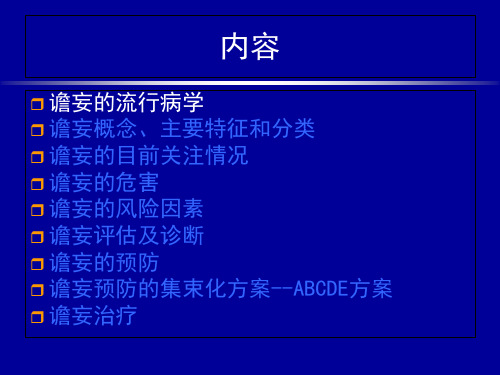
谵妄的危害
increased risk for prolonged mechanical ventilation, catheter removal,self-extubation, and the need for physical restraints.
In addition, delirium predisposes patients(有谵妄倾向患者) to longer hospital stays, with greater health care costs, increased risk of death during the hospitalization, and increased odds of institutionalization following discharge.
b) hypoactive delirium (characterized by psychomotor slowing, apathy(淡漠), lethargy(昏睡) and a decrease in response to external stimuli);
and c) mixed delirium (with unpredictable fluctuation of symptoms between the first two subtypes)
ICU谵妄评估工具
1.the Confusion Assessment Method-ICU (CAM-ICU)
把RASS评分整合到CAM-ICU确定有效的两个 版本:葡萄糖牙版本和英国版本
2.the Intensive Care Delirium Screening ) disturbance of consciousness with reduced awareness of the environment and impaired ability to focus, sustain, or shift attention;
医院关于印发术后谵妄防治方案
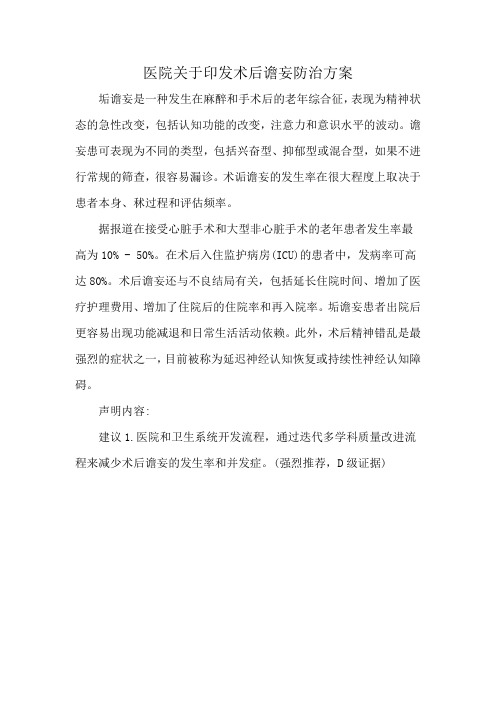
医院关于印发术后谵妄防治方案
垢谵妄是一种发生在麻醉和手术后的老年综合征,表现为精神状态的急性改变,包括认知功能的改变,注意力和意识水平的波动。
谵妄患可表现为不同的类型,包括兴奋型、抑郁型或混合型,如果不进行常规的筛查,很容易漏诊。
术诟谵妄的发生率在很大程度上取决于患者本身、秫过程和评估频率。
据报道在接受心脏手术和大型非心脏手术的老年患者发生率最高为10% - 50%。
在术后入住监护病房(ICU)的患者中,发病率可高达80%。
术后谵妄还与不良结局有关,包括延长住院时间、增加了医疗护理费用、增加了住院后的住院率和再入院率。
垢谵妄患者出院后更容易出现功能减退和日常生活活动依赖。
此外,术后精神错乱是最强烈的症状之一,目前被称为延迟神经认知恢复或持续性神经认知障碍。
声明内容:
建议1.医院和卫生系统开发流程,通过迭代多学科质量改进流程来减少术后谵妄的发生率和并发症。
(强烈推荐,D级证据)。
ABCDEF集束化策略在ICU谵妄患者中的应用PPT课件

临床表现
ICU谵妄的临床表现包括注意力不集中、定向力障碍、思维混 乱、焦虑、恐惧、躁动不安、睡眠障碍等。此外,患者还可 能出现幻觉、妄想等症状。
影响因素
ICU谵妄的发生受多种因素影响,如年龄、疾病严重程度、手 术类型、药物治疗、环境因素等。其中,年龄越大、疾病越 严重、手术越复杂的患者越容易发生ICU谵妄。
在实施过程中,我们强调了跨学科合作的重要性,通过医生、护士、药师等多方 共同参与,确保了策略的全面性和有效性。
局限性分析及改进措施提
局限性分析
尽管ABCDEF集束化策略在本次项目 中取得了一定成果,但仍存在部分患 者对策略的反应不佳,可能与患者个 体差异、病情严重程度等因素有关。
改进措施提出
针对局限性,我们建议进一步优化策 略,如根据患者特点进行个性化治疗 、加强患者和家属的教育等,以提高 策略的效果和适用性。
B(保持舒适)
定期为患者更换体位,减少长时间 卧床导致的压疮风险;保持病房安 静,降低噪音干扰。
C(早期活动)
在患者病情允许的情况下,尽早协 助患者进行床上活动或下床活动, 促进肢体功能恢复。
D(减少镇静药物使用)
尽量减少镇静药物的使用,采用非药 物性干预措施如音乐疗法、按摩等缓 解患者焦虑情绪。
E(早期拔除尿管)
感谢您的观看
住院时间缩短
应用ABCDEF集束化策略后, 患者病情恢复迅速,住院时间
明显缩短。
患者满意度提高
家庭参与和保持舒适等措施提 高了患者对护理工作的满意度
。
04 效果评估与持续改进计划
效果评估指标体系构建
谵妄发生率
统计实施集束化策略后 ICU患者谵妄的发生率
。
谵妄持续时间
记录患者谵妄持续的时 间,评估集束化策略对
ABCDEF集束化措施的内涵及实施过程中的挑战

ABCDEF集束化措施的内涵及实施过程中的挑战作者:张山崔薇吴瑛来源:《中国现代医生》2022年第22期谵妄是重症监护病房(intensive care units,ICU)患者较为常见但可预防的并发症,其发生率高达70%~87%[1,2]。
ICU患者发生谵妄可导致机械通气时间和住院时间延长,甚至病死率增加等[3]。
因此,应早期预防谵妄发生以改善其带来的不良影响[4,5]。
《ICU成年患者疼痛、躁动/镇静、谵妄、活动受限和睡眠紊乱预防及处理指南》(以下简称PADIS指南)建议使用ABCDEF集束化措施干预谵妄多个可改变的危险因素,以降低谵妄发生率[6]。
ABCDEF 集束化措施包括:A,疼痛的评估、预防和处理;B,每日唤醒试验和自主呼吸试验;C,镇痛剂及镇静剂的选择;D,谵妄的监测/处理;E,早期活动;F,家属参与和授权。
然而,在临床工作中,ABCDEF集束化措施的依从性不佳[4,7]。
因此,本文将针对ABCDEF集束化措施实施过程中存在的一些挑战,结合国内外专家学者的建议,提出相应的解决方案,为促进临床医护人员积极实施ABCDEF集束化措施提供理论依据。
1 ABCDEF集束化干预措施ABCDEF集束化措施是以护士为主导、以患者为中心的照护模式,目的在于恢复患者的身体和认知功能[8]。
1.1 ABCDEF集束化策略的内涵1.1.1 评估、预防和处理疼痛疼痛数字评分法(numeric rating scale,NRS)被认为是患者自我汇报疼痛的金标准。
在发现患者处于明显疼痛(NRS>3分)30min内给予治疗,首先考虑非药物治疗(如放松、抚触),无效时再考虑药物治疗(如阿片类药物)[6]。
1.1.2 每日唤醒试验和自主呼吸试验每日唤醒试验(spontaneous awakening trial,SAT)即在患者不存在活跃性疼痛的情况下,关闭所有镇静剂和镇痛剂的输入,可促进由药物引起的昏迷到有意识的过渡,降低机械通气时间,减少ICU并发症和住院费用[6,9];但对酒精戒断及维持在高水平镇静中的患者,SAT效果不明显[9]。
ICU谵妄的评估及预防

爱是什么? 一个精灵坐在碧绿的枝叶间沉思。 风儿若有若无。 一只鸟儿飞过来,停在枝上,望着远处将要成熟的稻田。 精灵取出一束黄澄澄的稻谷问道:“你爱这稻谷吗?” “爱。” “为什么?” “它驱赶我的饥饿。” 鸟儿啄完稻谷,轻轻梳理着光润的羽毛。 “现在你爱这稻谷吗?”精灵又取出一束黄澄澄的稻谷。 鸟儿抬头望着远处的一湾泉水回答:“现在我爱那一湾泉水,我有点渴了。” 精灵摘下一片树叶,里面盛了一汪泉水。 鸟儿喝完泉水,准备振翅飞去。 “请再回答我一个问题,”精灵伸出指尖,鸟儿停在上面。 “你要去做什么更重要的事吗?我这里又稻谷也有泉水。” “我要去那片开着风信子的山谷,去看那朵风信子。” “为什么?它能驱赶你的饥饿?” “不能。” “它能滋润你的干渴?” “不能。”爱是什么? 一个精灵坐在碧绿的枝叶间沉思。 风儿若有若无。 一只鸟儿飞过来,停在枝上,望着远处将要成熟的稻田。 精灵取出一束黄澄澄的稻谷问道:“你爱这稻谷吗?” “爱。” “为什么?” “它驱赶我的饥饿。” 鸟儿啄完稻谷,轻轻梳理着光润的羽毛。 “现在你爱这稻谷吗?”精灵又取出一束黄澄澄的稻谷。 鸟儿抬头望着远处的一湾泉水回答:“现在我爱那一湾泉水,我有点渴了。” 精灵摘下一片树叶,里面盛了一汪泉水。 鸟儿喝完泉水,准备振翅飞去。 “请再回答我一个问题,”精灵伸出指尖,鸟儿停在上面。 “你要去做什么更重要的事吗?我这里又稻谷也有泉水。” “我要去那片开着风信子的山谷,去看那朵风信子。” “为什么?它能驱赶你的饥饿?” “不能。” “它能滋润你的干渴?” “不能。”
药物监测
某些药物(如苯二氮卓类)本身可以引起患者出现躁动 等精神症状,肝肾功能低下者慎用
氟哌啶醇(对呼吸没有抑制作用)大量使用引起低血压、 恶性心律失常等不良反应
预防并发症
ICU患者谵妄的原因分析与护理措施精选全文
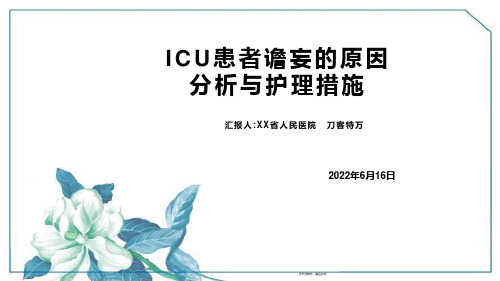
ICU患者谵妄的原因分析与护理措施
2、ICDSC表以DSM-IV(Diagnostic and Statistical Manual of Mental Disorders,4thEdn)的标准和谵妄的特征为基础,是一个包含8个项目的列表(表1)。ICDSC表的敏感度为99%,特异度到64%,精确度达0.94。8个项目中每一项根据其存在与否评1分或者0分,然后计算总分。总分≥4分提示存在谵妄。ICDSC表的优点是简单和快捷,并且许多观察项目被常规评估。
预防及护理
ICU患者谵妄的原因分析与护理措施
05
小结
小结
ICU谵安是可以预防的,谵安处理的关键在于预防,要尽量去除可能诱发谵安的危险因素。医务人员除了给予常规的医学监护外,合理的、及早的护理干预措施能有效预防ICU谵妄的发生。有大量的证据显示,愉悦健康的心理能对患者的生理恢复起到积极的促进作用;ICU的患者由于特殊的疾病因素和治疗环境,更易产生不利身体恢复的心理负担,因此,临床医务人员需加强对患者的心理护理,避免引起ICU谵妄发生的危险因素,以降低或防止ICU谵妄的发生。
谵妄的诊断
ICU患者谵妄的原因分析与护理措施
03
谵妄的危害及危险因素分析
谵妄的危害
1、增加死亡率:谵安状态对病死率的影响具有累计性,有关研究表明谵妄状态每持续一天,死亡的危险性就增加10%。2、增加机械通气病人脱机困难和脱机失败的比例。3、延长住院时间:有关研究表明ICU病人发生谵妄后,平均住院时间增加10天,无形之中也加重了患者的经济负担。4、增加认知障碍的发生率:有关研究表明,ICU病人发生谵妄后,只有4%的病人在出院时神经精神症状全部消失,约24%的病人遗留有长期认知障碍,老年病人痴呆的发生率显著高于未发生谵妄者。
ICU患者谵妄预防策略研究新进展

櫜櫜櫜櫜櫜櫜櫜櫜櫜櫜櫜櫜櫜櫜櫜櫜櫜櫜櫜櫜櫜櫜櫜櫜櫜櫜櫜櫜櫜櫜櫜櫜櫜櫜櫜櫜櫜櫜櫜櫜櫜櫜櫜櫜櫜櫜櫜櫜櫜[11]徐贞珍,姚爱英,潘红,等.五常法在手术室护理管理中的应用效果[J].中华现代护理杂志,2015,21(10):1180 1182.[12]詹西荣.6S管理法在手术室护理管理中的应用[J].当代护士(上旬刊),2018,25(19):179 180.[13]黄珍玲.6S管理法在急诊急救仪器管理中的应用[J].护理实践与研究,2017,14(3):98 99.[14]赵洪武,高?,张爽,等.6S管理模式在病区管理中的应用[J].护理实践与研究,2017,14(14):124 125.[15]于延玲,邵小莉,王莉.“6S”管理在神经外科管理中的效果分析[J].解放军医院管理杂志,2018,25(6):589 592.[16]赵文玲,林琴君,陈燕,等.“5S”现场管理在产房中的应用[J].解放军护理杂志,2015,32(10):58 59.[17]邓曼丽,陈文柯,韩燕敏.5S管理法在麻醉回复室感染控制中的应用[J].中华现代护理杂志,2014,20(19):2402 2404.[18]陆慰英,李拥军,乔田田.病区药品根本原因分析和五常法管理实践[J].中国实用护理杂志,2015,31(z1):211 213.[19]刘娅林,付沫,徐琴,等.病区冰箱药品的5S管理[J].护理学杂志,2016,31(1):78 80.[20]潘小华,董安,张洁.精益六西格玛提高手术后勤管理效 率研究[J].护士进修杂志,2018,33(12):1115 1117.[21]马鸿雁,张冬艳,鄢红,等.“5S”管理法在血液净化中心急救用物管理中的应用效果[J].中华现代护理杂志,2016,22(5):708 712.[22]杨嫦娥,席宏,刘变英,等.五常法管理模式在消化内镜中心的应用[J].护理研究,2014,28(1):366 367.[23]许静,刘传华.6S管理模式在提高消化内镜中心护理质量中的应用效果[J].中华现代护理杂志,2018,24(22):2716 2719.[24]ShogoK,AkiraS,MasamineJ.Applicablityofthe5Smanagementmethodforqualityimprovementinhealth carefacilities:areview[J].TropMedHealth,2016,44:21.[25]黄定凤,李京波,刘冬娇,等.应用6S管理模式提高临床护理管理质量[J].护理学杂志,2015,30(13):20,21,35.[26]李冰.以SOP与6S管理工具构建医院标准化服务程序[J].护理实践与研究,2016,13(19):14 18.[27]余丽,舒城仁.基于“6S”的OEC管理模式在PIVAS的实践[J].中国护理管理,2013,13(z1):45 46.[28]王锦佳,谢宝缘,郭萍.6S管理联合PDCA循环在病区医疗护理设备管理中的应用,2016,13(19):80 82.(本文编辑:李小玲)DOI:10.19791/j.cnki.1006 6411.2020.25.005工作单位:430022 武汉 华中科技大学同济医学院附属同济医院任小琼:女,本科,主管护师收稿日期:2019-05-05ICU患者谵妄预防策略研究新进展任小琼摘要 综述预防ICU谵妄发病率的策略,主要包括两个方面:谵妄风险预测和谵妄预防干预措施。
ABCDE集束化护理预防ICU机械通气病人谵妄的效果观察
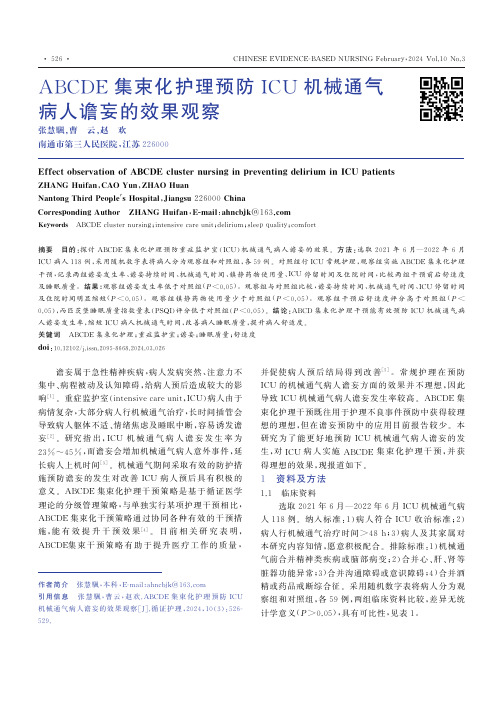
A B C D E集束化护理预防I C U机械通气病人谵妄的效果观察张慧颿,曹云,赵欢南通市第三人民医院,江苏226000E f f e c t o b s e r v a t i o no fA B C D Ec l u s t e r n u r s i n g i n p r e v e n t i n g d e l i r i u mi n I C U p a t i e n t sZ H A N G H u i f a n,C A OY u n,Z H A O H u a nN a n t o n g T h i r dP e o p l e'sH o s p i t a l,J i a n g s u226000C h i n aC o r r e s p o n d i n g A u t h o r Z H A N G H u i f a n,E-m a i l:a h n c b j k@163.c o mK e y w o r d s A B C D Ec l u s t e r n u r s i n g;i n t e n s i v e c a r eu n i t;d e l i r i u m;s l e e pq u a l i t y;c o m f o r t摘要目的:探讨A B C D E集束化护理预防重症监护室(I C U)机械通气病人谵妄的效果㊂方法:选取2021年6月 2022年6月I C U病人118例,采用随机数字表将病人分为观察组和对照组,各59例㊂对照组行I C U常规护理,观察组实施A B C D E集束化护理干预,记录两组谵妄发生率㊁谵妄持续时间㊁机械通气时间㊁镇静药物使用量㊁I C U停留时间及住院时间,比较两组干预前后舒适度及睡眠质量㊂结果:观察组谵妄发生率低于对照组(P<0.05)㊂观察组与对照组比较,谵妄持续时间㊁机械通气时间㊁I C U停留时间及住院时间明显缩短(P<0.05)㊂观察组镇静药物使用量少于对照组(P<0.05)㊂观察组干预后舒适度评分高于对照组(P< 0.05),而匹茨堡睡眠质量指数量表(P S Q I)评分低于对照组(P<0.05)㊂结论:A B C D集束化护理干预能有效预防I C U机械通气病人谵妄发生率,缩短I C U病人机械通气时间,改善病人睡眠质量,提升病人舒适度㊂关键词 A B C D E集束化护理;重症监护室;谵妄;睡眠质量;舒适度d o i:10.12102/j.i s s n.2095-8668.2024.03.026谵妄属于急性精神疾病,病人发病突然㊁注意力不集中㊁病程被动及认知障碍,给病人预后造成较大的影响[1]㊂重症监护室(i n t e n s i v e c a r e u n i t,I C U)病人由于病情复杂,大部分病人行机械通气治疗,长时间插管会导致病人躯体不适㊁情绪焦虑及睡眠中断,容易诱发谵妄[2]㊂研究指出,I C U机械通气病人谵妄发生率为23%~45%,而谵妄会增加机械通气病人意外事件,延长病人上机时间[3]㊂机械通气期间采取有效的防护措施预防谵妄的发生对改善I C U病人预后具有积极的意义㊂A B C D E集束化护理干预策略是基于循证医学理论的分级管理策略,与单独实行某项护理干预相比, A B C D E集束化干预策略通过协同各种有效的干预措施,能有效提升干预效果[4]㊂目前相关研究表明, A B C D E集束干预策略有助于提升医疗工作的质量,作者简介张慧颿,本科,E-m a i l:a h n c b j k@163.c o m引用信息张慧颿,曹云,赵欢.A B C D E集束化护理预防I C U 机械通气病人谵妄的效果观察[J].循证护理,2024,10(3):526-529.并促使病人预后结局得到改善[5]㊂常规护理在预防I C U的机械通气病人谵妄方面的效果并不理想,因此导致I C U机械通气病人谵妄发生率较高㊂A B C D E集束化护理干预既往用于护理不良事件预防中获得较理想的理想,但在谵妄预防中的应用目前报告较少㊂本研究为了能更好地预防I C U机械通气病人谵妄的发生,对I C U病人实施A B C D E集束化护理干预,并获得理想的效果,现报道如下㊂1资料及方法1.1临床资料选取2021年6月 2022年6月I C U机械通气病人118例㊂纳入标准:1)病人符合I C U收治标准;2)病人行机械通气治疗时间>48h;3)病人及其家属对本研究内容知情,愿意积极配合㊂排除标准:1)机械通气前合并精神类疾病或脑部病变;2)合并心㊁肝㊁肾等脏器功能异常;3)合并沟通障碍或意识障碍;4)合并酒精或药品戒断综合征㊂采用随机数字表将病人分为观察组和对照组,各59例,两组临床资料比较,差异无统计学意义(P>0.05),具有可比性,见表1㊂表1两组临床资料比较组别例数性别(例)男女年龄(xʃs,岁)急性生理学和慢性健康状况评分(xʃs,分)疾病所属科室(例)呼吸科心内科神经内科神经外科其他文化程度(例)初中及以下高中及中专专科及以上观察组59302945.23ʃ3.4520.02ʃ1.2820181263182219对照组59293045.69ʃ3.5220.23ʃ1.3822161083202019统计值χ2=0.034t=-0.717t=-0.857Z=0.680Z=0.201P0.8540.4750.3920.9540.9051.2护理1.2.1对照组行常规性机械通气护理,具体如下㊂1)病人机械通气48h后由责任护士对病人意识状况进行评估,对存在谵妄风险的病人提前采取保护性约束措施㊂2)机械通气期间密切留意病人心率㊁体温㊁血压等指标变化,并做好相应记录㊂3)严格遵从医嘱,切实认真履行 三查七对 ㊂4)机械通气期间密切留意导管是否出现受压㊁拉扯㊁脱落㊂5)在病人机械通气期间,由责任护士协助病人摆放舒适的体位㊂1.2.2观察组机械通气第1天由集束化护理管理团队对病人实施针对谵妄开展的A B C D E集束化护理干预,具体措施如下㊂1.2.2.1组建专业的集束化护理管理团队成员包括专业医师1名㊁康复治疗师2名及护理人员3名,所有参与护理的人员都需要进行理论学习与技术培训,根据科室㊁病房的实际情况制定工作计划,并做好分工,确保协调配合㊂1.2.2.2 A B C D E集束化护理干预方案内容1)每日唤醒(A):若接受机械通气治疗的病人不存在唤醒禁忌,则每日早上要停止使用镇静剂,医护人员需要对病人开展唤醒试验㊂试验过程中,若病人连续外周血氧饱和度连续5m i n低于88%㊁呼吸>35/m i n㊁呼吸窘迫明显㊁发生急性心律失常,则需要立刻停止试验,等到24h以后再行试验㊂2)自主呼吸试验(B):若唤醒试验顺利,则需要接着对病人开展自主呼吸试验,对病人的呼吸情况进行评估,确定合适的脱机拔管时间,然后对病人的呼吸情况以及意识变化展开观察㊂3)选择镇痛㊁镇静类药物(C):选择以镇痛为主的药物,基于浅镇静原则,让病人的镇静躁动评分量表(R A S S)评分保持在-2~1分㊂4)加强谵妄管理与预防(D):每日评估病人的谵妄情况,早晚各1次,以中文版医师模糊评估法(C A M-I C U)量表[6]及R A S S对I C U 病人谵妄情况进行评价,如果R A S S评分结果ɤ-3分,则需要持续对病人的意识情况进行监测,无需评估谵妄情况,4h以后再重新评分;若R A S S评分>-3分,则利用C AM-I C U量表分析病人是否出现谵妄情况㊂在管理谵妄时,需要及时改善环境,利用耳塞与眼罩让病人保持睡眠周期,避免缺氧㊂5)早期运动(E):对病人的实际状态做出精准评估后,为其制定早期个性化分级活动计划,计划的设计要科学合理,以保证病人的生命安全为前提㊂活动分级标准为:若病人R A S S评分ɤ-3分,仍处于昏迷状态,无法配合医护人员的指令,则采取一级活动,每隔2h帮助病人翻身拍背,每日早中晚帮助病人活动关节;若病人R A S S评分超过-3分,意识比较清晰,可完成医护人员的指令,则进行二级活动,早㊁中㊁晚让病人在床上保持坐姿,并完成抗阻力关节训练,每次训练时间为20m i n;若病人意识清晰,经过测试上肢肌力超过3级,则开展3级活动,在2级活动的基础上,增加每日床边活动,让病人在床边保持坐位;若病人意识清晰,经过测试下肢肌力超过3级,则开展4级活动,在3级活动的基础上,将病人转移到座椅上活动,每日活动时间为20m i n,若病人情况允许,可以让病人尝试步行训练㊂要依据病人的情况确定活动时间与强度,如果病人感觉不适,要立刻停止活动,并对情况加以处理,重新评估病人的情况,调整活动计划㊂1.3观察指标1)谵妄:病人机械通气24h后每天应用C A M-I C U 对病人进行3次谵妄筛查,有1次结果为阳性则为谵妄㊂根据谵妄类型可分为躁动型㊁安静型及混合型,谵妄发生率=谵妄例数/总例数ˑ100%㊂2)舒适度:在病人上机24h及上机后72h,由责任护士应用舒适状况量表(G C Q)[7]评估病人舒适性,量表包含30个条目,采用L i k e r t4级评分法,总评分为30~120分,分值越高,说明病人舒适性越理想㊂3)睡眠质量:在病人上机24h及上机后72h,由责任护士采用匹茨堡睡眠质量指数量表(P S Q I)[8]进行评价,量表共7个条目,采用L i k e r t3级评分法,总评分为7~21分,评分越高,说明病人睡眠质量越差㊂4)干预效果:记录两组谵妄持续时间㊁机械通气时间㊁镇静药物使用量㊁I C U停留时间及住院时间㊂1.4 统计学方法采用S P S S21.0软件进行统计分析,符合正态分布的定量资料用均数ʃ标准差(x ʃs )表示,行t 检验;定性资料采用例数㊁百分比(%)表示,行χ2检验㊂以P <0.05为差异有统计学意义㊂2 结果2.1 谵妄发生率观察组谵妄发生率为3.39%(2/59),对照组谵妄发生率为23.73%(14/59),两组比较,差异有统计学意义(P <0.05),见表2㊂表2 两组谵妄发生率比较单位:例(%)组别例数躁动型安静型混合型合计观察组591(1.69)1(1.69)0(0.00)2(3.39)对照组594(6.78)4(6.78)6(10.17)14(23.73) 注:两组谵妄发生率比较,P <0.001㊂2.2 G C Q 评分及P S Q I 评分干预前,两组G C Q 评分及P S Q I 评分比较,差异无统计学意义(P >0.05),干预后,观察组G C Q 评分高于对照组(P <0.05),而观察组P S Q I 评分低于对照组(P <0.05),见表3㊂表3 两组G C Q 评分及P S Q I 评分比较(x ʃs )单位:分组别例数 G C Q 评分 干预前干预后P S Q I 评分 干预前干预后观察组5964.25ʃ3.9895.25ʃ5.6317.12ʃ3.2210.25ʃ2.12对照组5964.50ʃ4.2578.22ʃ4.8817.63ʃ3.9614.63ʃ3.52t 值-0.33017.557-0.767-8.187P0.742<0.001 0.444<0.0012.3 干预效果(见表4)表4 两组干预效果比较(x ʃs )组别例数谵妄持续时间(d )机械通气时间(d )I C U 停留时间(d )住院时间(d )镇静药物使用量(m g)观察组593.45ʃ0.864.98ʃ0.8910.23ʃ2.3617.25ʃ3.26182.12ʃ25.23对照组592.26ʃ0.527.69ʃ1.236.98ʃ1.8513.98ʃ2.89225.26ʃ26.98t 值 9.095-13.711 8.325 5.765 8.971P<0.001<0.001<0.001<0.001<0.0013 讨论3.1 A B C D E 集束化护理干预能降低I C U 机械通气病人谵妄发生率,缩短谵妄持续时间 I C U 机械通气病人由于身体约束㊁气管插管㊁语言障碍㊁仪器报警及缺乏家属陪伴等因素影响,会加重病人恐惧及焦虑情绪,影响病人睡眠质量,因此增加病人术后谵妄发生风险[9]㊂研究指出,机械通气期间为病人提供舒适的住院环境,改善病人心理舒适度及睡眠质量,能有效预防谵妄的发生[10]㊂A B C D E 集束化护理干预是基于循证医学理论,跨多个学科的管理方法,可有效提升护理质量,改善病人预后[11]㊂本研究对I C U 机械通气病人实施A B C D E 集束化护理干预,结果显示,观察组干预后谵妄发生率明显低于对照组(P <0.05),且观察组谵妄持续时间明显短于对照组(P <0.05),表明A B C D E 集束化护理干预能降低谵妄的发生率,缩短谵妄持续时间㊂这是因为A B C D E 集束化护理针对引起谵妄的相关风险因素从疼痛评估㊁镇静管理㊁谵妄评估㊁早期活动等多方面为病人提供针对性及系统性的护理干预服务,从而有效预防谵妄发生,缩短谵妄发生时间[12]㊂3.2 A B C D E 集束化护理干预能改善病人睡眠质量,提升病人舒适度机械通气病人受约束㊁灯光持续照射㊁I C U 仪器报警声等因素刺激及影响,会影响病人舒适度,诱发病人睡眠障碍[13]㊂本研究通过成立A B C D E 集束化护理干预团队对机械通气病人实施护理干预,结果显示,干预后,观察组G C Q 评分高于对照组(P <0.05),而观察组P S Q I评分低于对照组(P<0.05),从而表明A B C D E集束化护理干预能改善病人睡眠质量,提升病人舒适度㊂这是因为A B C D E集束化护理干预通过给予病人镇静管理,可有效解除病人约束,避免长时间约束导致病人出现不适感[14]㊂另外,A B C D E集束化护理干预通过指导病人开展循序渐进式的早期功能锻炼,通过早期功能锻能让病人躯体症状得到明显改善,避免躯体不适而影响睡眠质量[15]㊂3.3 A B C D E集束化护理可改善I C U机械通气病人预后本研究结果显示,干预后,观察组与对照组比较,机械通气时间㊁I C U停留时间及住院时间明显缩短(P< 0.05),观察组镇静药物使用量少于对照组(P<0.05),表明A B C D E集束化护理干预可改善I C U机械通气病人预后㊂这是因为通过成立A B C D E集束化护理干预团队能最大程度提升团队合作能力,从而确保各项干预措施能有效落实,进而促进了病人康复[16]㊂另外,A B C E D集束化护理干预从多方面为病人提供系统化㊁全面化的护理指导,可有效改善病人护理工作中存在的不足,有效预防谵妄发生,并有助于病人生命体征改善,从而缩短病人机械通气时间,促进病人预后及康复[17-18]㊂4小结A B C D E集束化护理干预能有效预防I C U机械通气病人谵妄发生,缩短I C U病人机械通气时间,改善病人睡眠质量,提升病人舒适度㊂由于A B C D E集束化护理干预的实施需要多学科医护人员相互配合,在日后工作中需要加强学科间的沟通,以便相关护理干预工作能更好地实施㊂参考文献:[1]李九红,黄伶智,周艳红,等.I C U成人患者谵妄预防及管理策略的最佳证据总结[J].护士进修杂志,2022,37(5):439-445. [2]贺格格,唐光明,刘琼,等.I C U护士谵妄知信行现状研究进展[J].护理研究,2022,36(1):110-113.[3]孙智颖,倪冬姝,马宏飞,等.危重症患者发生谵妄的危险因素分析[J].中国医科大学学报,2022,51(1):23-27.[4]周家梅,徐晓君,钟威,等.A B C D E集束化护理措施在心脏瓣膜置换术后谵妄患者中的应用及效果观察[J].护士进修杂志,2021,36(16):1489-1492.[5]陈俊杉,范杰梅,余金甜,等.神经外科I C U患者谵妄风险预测模型的构建与验证[J].护理学报,2021,28(4):1-8.[6] L I N S T R UM K,N U Z Z O E,C U R T I SB,e ta l.C o m p a r i s o no f t h eC o n f u s i o nA s s e s s m e n tM e t h o d f o r t h e I C U(C AM-I C U)a n dt h eI n t e n s i v eC a r eD e l i r i u mS c r e e n i n g C h e c k l i s t(I C D S C)f o r d e l i r i u md e t e c t i o n i n m e c h a n i c a l l y v e n t i l a t e dI C U p a t i e n t s[J].A m e r i c a nJ o u r n a l o fR e s p i r a t o r y a n dC r i t i c a lC a r e M e d i c i n e,2019,199(2): 85-86.[7]朱丽霞,高凤莉,罗虹辉,等.舒适状况量表的信效度测试研究[J].中国实用护理杂志,2006,22(13):57-59.[8] S MY T H C.T h e P i t t s b u r g h S l e e p Q u a l i t y I n d e x[J].M e d s u r gN u r s i n g:O f f i c i a lJ o u r n a lo ft h e A c a d e m y o f M e d i c a l-S u r g i c a lN u r s e s,2003,12(4):261-262.[9]王春燕,雷蕾,薛雅文,等.机械通气患儿A B C D E集束化镇静镇痛策略研究进展[J].护士进修杂志,2021,36(3):235-239. [10]吉云兰,徐旭娟,单君,等.严重创伤患者谵妄发生风险预测模型的构建[J].中华护理杂志,2020,55(6):811-816. [11]李真,李奇,李尊柱,等.I C U患者亚谵妄综合征患病率及危险因素的系统评价[J].中华护理杂志,2020,55(2):288-293. [12]成晶,席明霞,周朝阳,等.e C A S H策略预防I C U机械通气患者谵妄效果评价[J].护理学杂志,2019,34(20):27-30. [13]江小香,詹斌.非药物集束化护理方案对I C U谵妄患者的应用效果探索[J].中国医药指南,2019,17(25):291-292. [14]刘培培,李津,王晓冉,等.A B C D E集束化干预在I C U机械通气病人中应用效果的M e t a分析[J].循证护理,2018,4(6):481-487.[15]麻苗,郭俊玲,白妮,等.镇静镇痛集束策略对机械通气患者谵妄及临床预后的干预研究[J].中国实用护理杂志,2018,34(15): 1150-1153.[16]王丽,许华,单世君,等.集束化护理方案对I C U机械通气患者谵妄发生和预后的影响[J].川北医学院学报,2022,37(9):1231-1234.[17]刘雪花,陈应柱,窦英茹.集束化护理干预在心脏大血管手术后谵妄患者中的临床应用进展[J].护理实践与研究,2022,19(7): 983-988.[18]金玲丽,袁莉萍,江海娇,等.镇静镇痛集束护理对I C U病人谵妄影响的M e t a分析[J].循证护理,2020,6(8):762-769.(收稿日期:2023-03-03;修回日期:2023-11-18)(本文编辑薛佳)。
ABCDE集束化管理方法在预防ICU获得性谵妄病人中的应用与护理
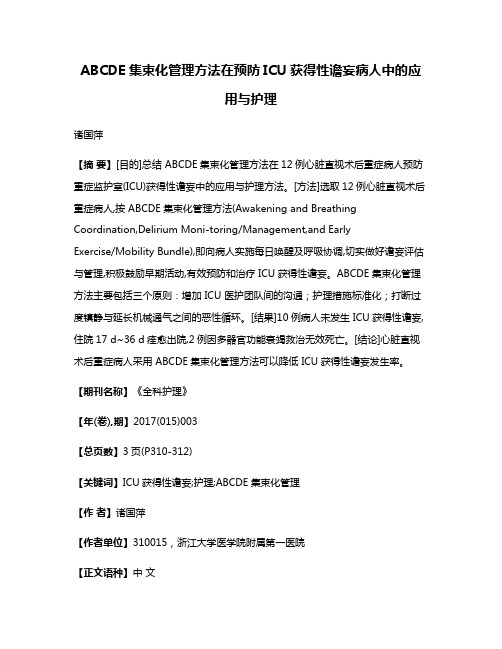
ABCDE集束化管理方法在预防ICU获得性谵妄病人中的应用与护理诸国萍【摘要】[目的]总结 ABCDE集束化管理方法在12例心脏直视术后重症病人预防重症监护室(ICU)获得性谵妄中的应用与护理方法。
[方法]选取12例心脏直视术后重症病人,按 ABCDE集束化管理方法(Awakening and Breathing Coordination,Delirium Moni-toring/Management,and EarlyExercise/Mobility Bundle),即向病人实施每日唤醒及呼吸协调,切实做好谵妄评估与管理,积极鼓励早期活动,有效预防和治疗 ICU获得性谵妄。
ABCDE集束化管理方法主要包括三个原则:增加 ICU 医护团队间的沟通;护理措施标准化;打断过度镇静与延长机械通气之间的恶性循环。
[结果]10例病人未发生 ICU获得性谵妄,住院17 d~36 d痊愈出院,2例因多器官功能衰竭救治无效死亡。
[结论]心脏直视术后重症病人采用 ABCDE集束化管理方法可以降低 ICU获得性谵妄发生率。
【期刊名称】《全科护理》【年(卷),期】2017(015)003【总页数】3页(P310-312)【关键词】ICU获得性谵妄;护理;ABCDE集束化管理【作者】诸国萍【作者单位】310015,浙江大学医学院附属第一医院【正文语种】中文【中图分类】R473.5重症监护室(ICU)后综合征(post-intensive care syndrome,PICS)是指重症病人在生理、认知和心理方面新出现或加重的一系列功能障碍,这些障碍会持续影响病人本人或病人家属[1-2]。
而ICU获得性谵妄(intensive care unit acquired delirium)是其中一种,表现为病人机体功能以及认知障碍,导致机械通气时间延长,增加医疗费用,更严重影响病人生活质量甚至降低了存活率[3-4]。
因此,需积极预防和治疗ICU获得性谵妄,改善病人预后。
ICU谵妄危险因素分析及非药物性预防措施
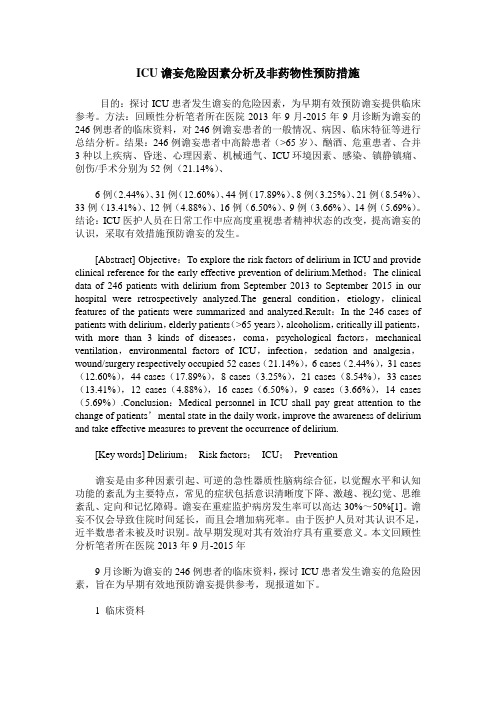
ICU谵妄危险因素分析及非药物性预防措施目的:探讨ICU患者发生谵妄的危险因素,为早期有效预防谵妄提供临床参考。
方法:回顾性分析笔者所在医院2013年9月-2015年9月诊断为谵妄的246例患者的临床资料,对246例谵妄患者的一般情况、病因、临床特征等进行总结分析。
结果:246例谵妄患者中高龄患者(>65岁)、酗酒、危重患者、合并3种以上疾病、昏迷、心理因素、机械通气、ICU环境因素、感染、镇静镇痛、创伤/手术分别为52例(21.14%)、6例(2.44%)、31例(12.60%)、44例(17.89%)、8例(3.25%)、21例(8.54%)、33例(13.41%)、12例(4.88%)、16例(6.50%)、9例(3.66%)、14例(5.69%)。
结论:ICU医护人员在日常工作中应高度重视患者精神状态的改变,提高谵妄的认识,采取有效措施预防谵妄的发生。
[Abstract] Objective:To explore the risk factors of delirium in ICU and provide clinical reference for the early effective prevention of delirium.Method:The clinical data of 246 patients with delirium from September 2013 to September 2015 in our hospital were retrospectively analyzed.The general condition,etiology,clinical features of the patients were summarized and analyzed.Result:In the 246 cases of patients with delirium,elderly patients(>65 years),alcoholism,critically ill patients,with more than 3 kinds of diseases,coma,psychological factors,mechanical ventilation,environmental factors of ICU,infection,sedation and analgesia,wound/surgery respectively occupied 52 cases(21.14%),6 cases(2.44%),31 cases (12.60%),44 cases(17.89%),8 cases(3.25%),21 cases(8.54%),33 cases (13.41%),12 cases(4.88%),16 cases(6.50%),9 cases(3.66%),14 cases (5.69%).Conclusion:Medical personnel in ICU shall pay great attention to the change of patients’mental state in the daily work,improve the awareness of delirium and take effective measures to prevent the occurrence of delirium.[Key words] Delirium;Risk factors;ICU;Prevention谵妄是由多种因素引起、可逆的急性器质性脑病综合征,以觉醒水平和认知功能的紊乱为主要特点,常见的症状包括意识清晰度下降、激越、视幻觉、思维紊乱、定向和记忆障碍。
- 1、下载文档前请自行甄别文档内容的完整性,平台不提供额外的编辑、内容补充、找答案等附加服务。
- 2、"仅部分预览"的文档,不可在线预览部分如存在完整性等问题,可反馈申请退款(可完整预览的文档不适用该条件!)。
- 3、如文档侵犯您的权益,请联系客服反馈,我们会尽快为您处理(人工客服工作时间:9:00-18:30)。
谵妄的主要特征
(3) disturbance that develops over a short period of time (hours to days) and tends to fluctuate during the course of the day;
(4) evidence of an etiologic factor (ie, delirium due to general medical condition, substance-induced delirium, delirium due to multiple causes, or delirium not otherwise specified)
谵妄在ICU很常见 60-80%机械通气患者发生谵妄 20-50%非机械通气患者发生谵妄
内容
谵妄的流行病学 谵妄概念、主要特征和分类 谵妄的目前关注情况 谵妄的危害 谵妄的风险因素 谵妄评估及诊断 谵妄的预防 谵妄预防的集束化方案--ABCDE方案 谵妄治疗
(1) disturbance of consciousness with reduced awareness of the environment and impaired ability to focus, sustain, or shift attention;
(2) altered cognition (eg, impaired memory, language disturbance, or disorientation) or the development of a perceptual(知觉) disturbance (eg, hallucinations(幻 觉), delusions(妄想), or illusions(错觉)) that is not better accounted for by preexisting or evolving dementia (痴呆);
Delirium
-谵妄
南华大念、主要特征和分类 谵妄的目前关注情况 谵妄的危害 谵妄的风险因素 谵妄评估及诊断 谵妄的预防 谵妄预防的集束化方案--ABCDE方案 谵妄治疗
流行病学
Delirium occurs in up to 80% of patients admitted to intensive care units. Although under-diagnosed, delirium is associated with a significant increase in morbidity and mortality in critical patients.
谵妄分类--运动亚型
2.The terminology according to motor subtypes includes
a) hyperactive delirium (in which there is an increase in the psychomotor activity and agitation, with attempts to remove invasive devices);
谵妄分类--发病时间
The classification of delirium can be subdivided by course over time and motor subtypes.
1.The terminology, according to the course over time, includes
ICU患者谵妄发生率接近80% 尽管谵妄诊断不足,谵妄与明显增加危重
患者发病率和病死率相关
流行病学
Delirium is common in the ICU, affecting 60% to 80% of mechanically ventilated patients and 20% to 50% of nonmechanically ventilated patients
a) prevalent (if it is detected at the time of admission);
b) incident (if it emerges during the hospital length of stay);
and c) persistent (if the symptoms persist over time)
概念
Delirium in the intensive care unit (ICU) represents an acute form of organ dysfunction,which manifests as a rapidly developing disturbance of both consciousness and cognition that tends to fluctuate throughout the course of a day
b) hypoactive delirium (characterized by psychomotor slowing, apathy(淡漠), lethargy(昏睡) and a decrease in response to external stimuli);
谵妄以急性器官功能障碍为表现形式:倾向于1天 内波动性的、迅速发展的意识和认知紊乱。
谵妄的主要特征
The American Psychiatric Association (APA)Diagnostic and Statistical Manual of Mental Disorders,fourth edition, text revision (DSM-IV) defines 4 key features of delirium:
